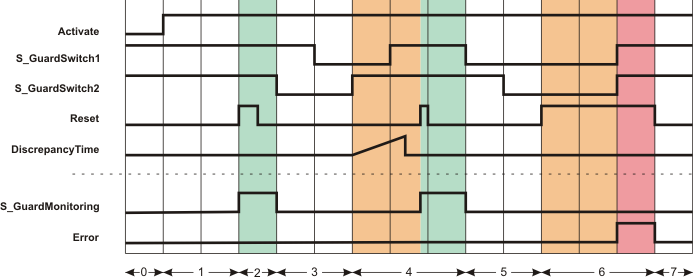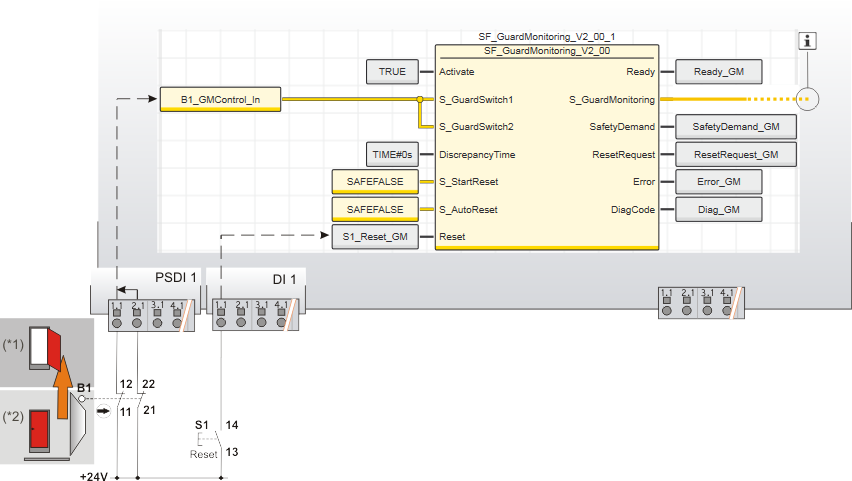- Home
- Function/Function Block Reference
- Safety-Related PLCopen Function Blocks
- SF_GuardMonitoring
SF_GuardMonitoring
Help version 1.1 / Issue date: 2018.03
The following description is valid for the function block SF_GuardMonitoring_V2_0z, Version 2.0z (where z = 0 to 9).
| Short Description | The safety-related SF_GuardMonitoring function block monitors a guard (e.g., door) with two-stage interlocking according to the DIN EN ISO 14120 standard.S_StartReset can be used to specify a start-up inhibit and S_AutoReset can be used to specify a restart inhibit. | ||||||||||||||||||||||||||||||||||
| Block Icon | |||||||||||||||||||||||||||||||||||
| Inputs |  Activate Activate
Refer to the topic "Activate" for details.  S_GuardSwitch1 and S_GuardSwitch2 S_GuardSwitch1 and S_GuardSwitch2
Refer to the topic "S_GuardSwitch1 and S_GuardSwitch2" for details.  DiscrepancyTime DiscrepancyTime
Refer to the topic "DiscrepancyTime" for details.  S_StartReset S_StartReset
Refer to the topic "S_StartReset" for details.  S_AutoReset S_AutoReset
Refer to the topic "S_AutoReset" for details.  Reset Reset
Resetting the function block by means of a positive signal edge at the Reset input can cause the S_GuardMonitoring output to switch to SAFETRUE immediately (depending on the status of the other inputs).
Refer to the topic "Reset" for details. |
||||||||||||||||||||||||||||||||||
| Outputs |  Ready Ready
Refer to the topic "Ready" for details.  S_GuardMonitoring S_GuardMonitoring
Refer to the topic "S_GuardMonitoring" for details.  SafetyDemand SafetyDemand
Refer to the topic "SafetyDemand" for details.  ResetRequest ResetRequest
Refer to the topic "ResetRequest" for details.  Error Error
Refer to the topic "Error" for details.  DiagCode DiagCode
Refer to the topic "DiagCode" for details. |
||||||||||||||||||||||||||||||||||
| Detailed information |  Signal sequence diagram Signal sequence diagram
This diagram is based on typical monitoring of a guard with two-stage interlocking, where both position switches connected to inputs S_GuardSwitch1 and S_GuardSwitch2 switch within the time set at DiscrepancyTime. S_StartReset = SAFEFALSE: Start-up inhibit after the function block has been activated and the Safety PLC has started up S_AutoReset = SAFEFALSE: Restart inhibit after the previously opened safety equipment has been closed (i.e., after the SAFETRUE signals have returned at inputs S_GuardSwitch1 and S_GuardSwitch2).
 Application example: Door monitoring using a mechanical position switch, start-up inhibits activated Application example: Door monitoring using a mechanical position switch, start-up inhibits activated
This example describes how a mechanically activated position switch with 2 N/C contacts is evaluated using the safety-related SF_GuardMonitoring function block. Position switch B1 is connected to input terminals 1.1 and 2.1 of safety-related input device PSDI 1. The signals from position switch B1 are evaluated, based on two channels, for equivalence in the safety-related input device, which has been parameterized accordingly. The resulting signal is assigned to the global I/O variable B1_GMControl_In. This variable is connected to the inputs S_GuardSwitch1 and S_GuardSwitch2 of the safety-related SF_GuardMonitoring function block for evaluation.
The function block is perpetually activated by a TRUE constant at the Activate input. S_StartReset = SAFEFALSE specifies a start-up inhibit after the Safety PLC has been started up or the function block has been activated. Furthermore, S_AutoReset = SAFEFALSE specifies a restart inhibit for the function block after the door has been closed. Both inhibits are only removed when there is a positive signal edge at the Reset input.
 Function block instantiation Function block instantiation
The IEC 61131-3 standard defines function block instantiation. Instantiation means, a function block is defined once and can be used (instantiated) several times. This applies to all FBs (user-defined POUs as well as library FBs, such as IEC standard FBs, firmware FBs, user library FBs).
Why instantiation? The following applies:
The user-defined function block 'TLC' ("Two Level Controller") is added to the 'Functions & Function Blocks' category (COMPONENTS area). It shall be called twice in the program POU 'Container' to control the filling level and the temperature of a boiler. For both FB instances, an instance name declaration is added to the 'Variables' table of the calling program POU 'Container': TLCTemperature and TLCLevel. Thus the 'TLC' function block can be called twice in the code worksheet of the calling POU by means of these instance names. |




